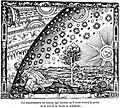File:FlammarionWoodcut.jpg

Dimenziune de sta andeprime: 660 x 600 pixel. Otre resoluziune: 264 x 240 pixel • 528 x 480 pixel • 845 x 768 pixel • 1 127 x 1 024 pixel • 2 254 x 2 048 pixel • 2 934 x 2 666 pixel.
File origgenale (2 934 × 2 666 pixel, dimenzione d'u fail: 9 MB, tipe de MIME: image/jpeg)
cunde
Cazze sus 'na date/orarie pe vedè 'u fail a cumme asseva jndr'à quidde timbe.
| Sciurne/Orarie | Thumbnail | Dimenziune | Utende | Commende | |
|---|---|---|---|---|---|
| corrende | 16:58, 3 Lug 2020 |  | 2 934 × 2 666 (9 MB) | Sette-quattro | High quality scan with the original caption, from http://urn.fi/URN:NBN:fi-fe2020052939747. Image has been deskewed. |
| 09:38, 19 Sci 2014 |  | 1 157 × 1 046 (703 KB) | DxhaFFer | There are two black-and-white versions of this image. One is supposed to have the caption underneath the engraving, the other one is supposed to be without it. This is the large version of the image with the caption taken from the page of the version w... | |
| 03:33, 14 Mar 2006 |  | 1 162 × 973 (295 KB) | Brian Brondel | higher resolution | |
| 01:20, 9 Sci 2005 |  | 504 × 455 (118 KB) | Sparkit | Flammarion Woodcut. See wikipedia:Flammarion Woodcut {{PD-art}} |
Ause d'u file
Non ge stonne pàggene ca appodene a stu fail.
Ause d'u file globale
Le seguende Uicchi ausane stu file:
- Ause sus a als.wikipedia.org
- Ause sus a ar.wikipedia.org
- Ause sus a ar.wikiversity.org
- Ause sus a ast.wikipedia.org
- Ause sus a bg.wikipedia.org
- Ause sus a ca.wikipedia.org
- Ause sus a de.wikipedia.org
- Metaphysik
- Schamanismus
- Sternenhimmel
- Firmament
- Wikipedia:Wikipedianer/Soundtrack der Wikipedianer
- Portal:Philosophie/Ausgezeichnete Artikel
- Dualismus
- Wikipedia:Auskunft/Archiv/2006/Juni/3
- Portal:Philosophie/Lesenswerte Artikel
- Portal:Philosophie/Lesenswerte Artikel/Disziplinen und Begriffe
- Portal:Philosophie/Artikel der Woche/51
- Wikipedia:Café/Archiv 2010 Q1
- Diskussion:Weltbild
- Religionsanthropologie
- Benutzer:HerbertErwin/Metaphysik
- Benutzer:NeulichBeimOntologen
- Ause sus a en.wikipedia.org
- Ause sus a en.wikibooks.org
- Ause sus a en.wikisource.org
- Ause sus a en.wikiversity.org
- Ause sus a en.wiktionary.org
- Ause sus a es.wikipedia.org
- Ause sus a et.wikipedia.org
- Ause sus a eu.wikipedia.org
- Ause sus a frp.wikipedia.org
- Ause sus a fr.wikipedia.org
- Ause sus a fr.wikiversity.org
Vide ause globale de stu file.




